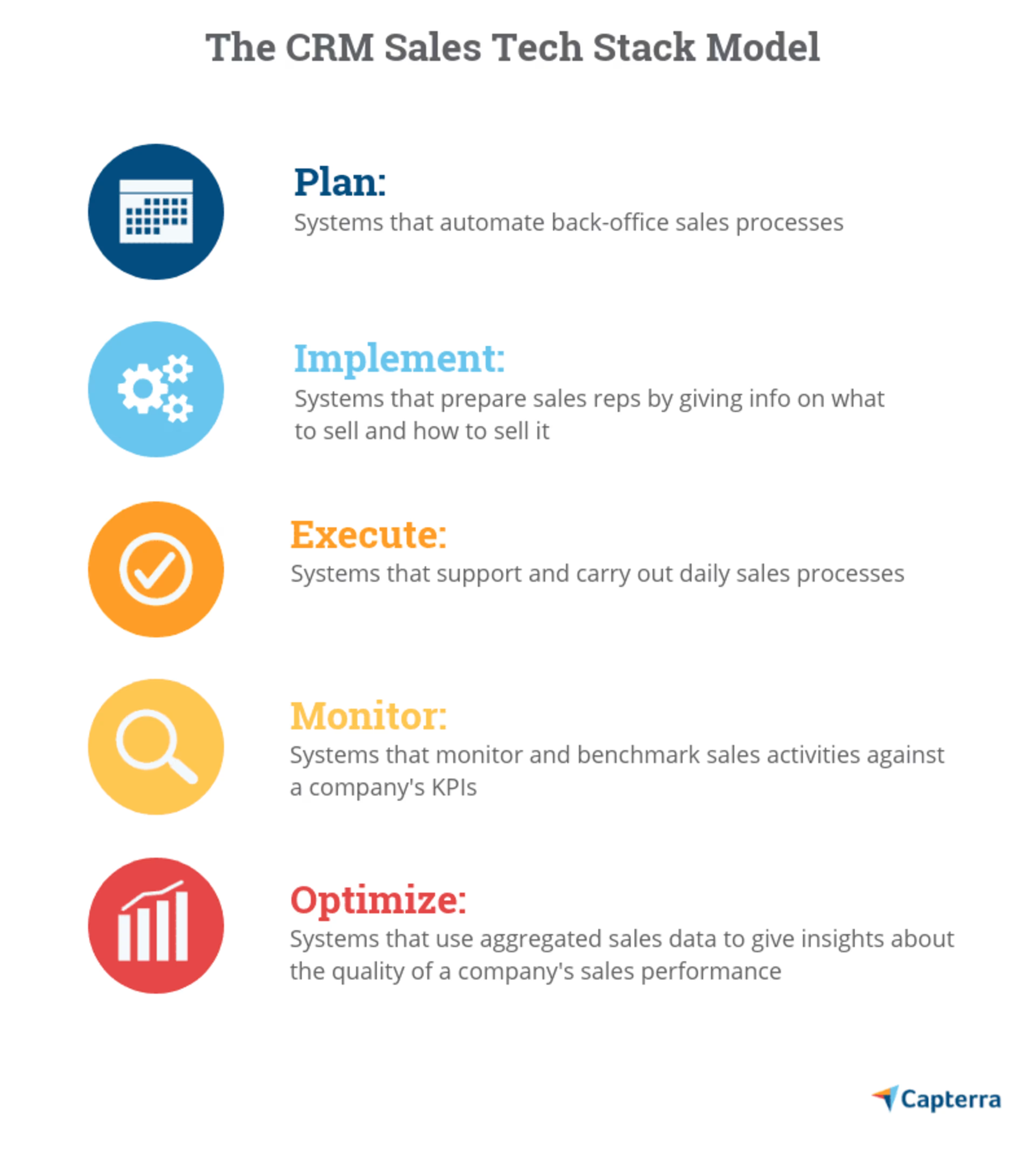Does your sales stack stack up? According to HubSpot research, probably not; 40% of sales people don't go beyond Excel or Outlook to store lead and customer data.
If that's as far as you've gone in creating your sales tech stack, you've got a problem.

A sales stack is a set of software tools used to carry out the range of activities that help a business plan, implement, execute, monitor, and optimize their sales strategy.
As data becomes a key factor for developing and executing a successful sales strategy, technology will play a leading role in businesses' ability to collect and make use of that data. Technology will be the competitive advantage that will ensure your sales team is maximizing its ROI while minimizing effort.
Using only Excel or Outlook won't quite cut it. You need a sales stack that can push your business to new heights.
Sales teams that use technologies to address each stage of the strategic sales process will see a better ROI from their software investment than those that use ad hoc tools without a strategy.
But what are these stages, and which technologies can meet the needs of each?
The CRM sales technology stack model
Gartner's CRM Sales Tech Stack Model outlines the five strategic stages of the sales process that your sales stack should be able to carry out (full report available to clients):

Let's go through each of these stages and look at the tools that can help you execute each one. Keep in mind that one software tool might meet the needs of more than one stage.
Stage 1: Plan
Systems that automate back-office sales processes
Before your sales team hits the floor, your business needs to lay out its objectives and how it plans to achieve them.
This isn't so much strategic as it is the practical implementation of sales processes and the allocation of resources.
The planning stage is about being thorough and exhaustive to leave as little room for error as possible.
Here, you want to:
1. Turn objectives into goals. Bring your objectives down from high-level strategy to concrete numbers. Crunch the numbers by asking questions like:
How much do we need to sell to hit these goals?
When do we need to reach these targets by?
Do we have enough product volume to reach our sales goals?
2. Plan resources accordingly. Once you know what numbers you need to hit, you'll have a better idea of what's possible based on your budget. Ask questions like:
How many sales reps do we need?
What will their compensation plans look like?
Which territories do they cover?
At this stage, software to add to your sales stack includes:
CPQ software: Configure, price, and quoting (CPQ) software helps companies price products or services and generate quotes based on resources and optimal pricing strategies.
SPM software: Sales performance management (SPM) software lets companies manage objectives and quotas for sales reps, as well as carrying out territory planning and compensation management. You can also use it to monitor sales performance in real time to adjust priorities and allocate resources accordingly.
Stage 2: Implement
Systems that prepare sales reps by giving info on what to sell and how to sell it
You've got your plan in place—now it's time to get everybody on the same page. The implementation phase starts putting your plan into action by ensuring that everyone on the sales team has the tools they need to sell.
This includes knowledge about sales processes but also knowledge about what they're selling.
Here, you want to:
Train employees on processes: A process only works if people follow it. Set up training sessions for sales team members so they know how to get from point A to point B to close a deal. This should be both strategic (knowing when to move the customer along the pipeline) as well as practical (workflow steps).
Train employees on products: There's nothing worse than fumbling for the answer to a customer's product-related question. Provide sales teams with materials that give them information about the product or service on offer. Materials should be tailored to specific stages of the sales funnel, and reps should know when and how to use them.
At this stage, software to add to your sales stack includes:
LMS: Learning management systems (LMS) provide an online training environment to deliver training programs. There are even some LMS options specifically developed for sales.
Sales enablement software: These tools offer a centralized repository for sales materials that can be used during the selling process. These are mostly created by the marketing team and are a good way to start aligning your sales and marketing processes.
Stage 3: Execute
Systems that support and carry out daily sales processes
Execution is where all the magic happens. The sales team puts its knowledge and skills into practice as reps goes through the sales process to try to find prospects, move leads through the pipeline, and follow up with customers.
Every action a sales rep takes to close a deal is part of the execution stage. The key factors here are lead management and sales automation.
Here, you want to:
Manage leads: Find, record, and track all leads, prospects, and customers. Make sure that you know which stage they are at in the pipeline, and when the best time to reach out to them is.
Automate tasks: Automating tasks can save sales reps a ton of time. Record interactions with customers and set reminders for outreach and milestones to help move deals through the pipeline. Tasks like inventory monitoring or order tracking can also be automated.
At this stage, software to add to your sales stack includes:
Lead management software: These tools collect customer information to help reps move leads through the pipeline. They can also make use of that information for forecasting and predicting future sales activities.
SFA software: Sales force automation (SFA) software does exactly what the name implies: automates repetitive sales tasks. This includes tracking customer communication, sending emails, and sending push notifications to sales reps for follow up actions. Many SFA systems also offer lead management and CRM functionality.
Stage 4: Monitor
Systems that monitor and benchmark sales activities against a company's KPIs
Most sales teams are results driven. Knowing how the team is performing is essential to gauging whether your sales plan, implementation, and execution has been successful.
This involves keeping an eye on the way that individual reps are performing, but also on pipeline health, deals won, and overall revenue.
Here, you want to:
Monitor sales rep performance: Check in on the progress of sales reps regularly as they aim to hit their targets. Look at where they're spending their time, how their pipelines are progressing, and what their close rates are. This will help you spot gaps in your overall revenue stream. Monitoring and benchmarking performance is also important to spot opportunities to coach your reps.
Report on sales team performance: In contrast to individual monitoring, sales reporting shows aggregate data to give an overview of how your entire sales team is performing. Look at your sales stats weekly and monthly to track the progress of deals, revenue streams, and generated leads.
At this stage, software to add to your sales stack includes:
Reporting software: Reporting tools and dashboards can come as standalone data analysis tools, or be included in your CRM suite. They summarize sales figures in real time as deals close and give an overview of things like average deal value, win rate, and a breakdown of the sales pipeline.
CRM software: While SPM software helps you coach and assess individual sales rep performance, most CRMs have built in features that let you monitor calls, revenue, and deal progress of your entire sales team.
Stage 5: Optimize
Systems that use aggregated sales data to give insights about the quality of a company's sales performance
Collecting data about sales is great, but it's even more useful if you're able to interpret it.
With AI-powered features taking shape in many CRM tools, it's becoming easier to use data for better resource planning, sales forecasting, and even pricing.
Here, you want to:
Make better sales forecasts: Use historical data to make predictions about future sales numbers. Sales forecasting takes seasonality, previous sales periods, and resources into account to allow for more accurate forecasts on expected sales numbers.
Interpret data to improve processes: Look for patterns in sales activity and results. Try to find a correlation between the two to decipher how processes are being helped or hindered and what could be improved in the planning stage to drive more revenue.
At this stage, software to add to your sales stack includes:
Sales forecasting software: These tools use historical data and external cues such as market fluctuations and seasonality to allow for better planning and predictions of expenses and revenue. It's worth noting that sales forecasting is also present in many CRM systems.
Predictive analytics software: Beyond forecasting sales figures, predictive analytics software leverages big data to help companies make informed decisions about everything from pricing to lead management.
Don't overstack your stack
You want a sales stack that's robust, but you don't want to overdo it. Adopting too many tools at once can lead to redundant features and wasted money.
There are plenty of tools that can serve multiple strategic categories based on their feature set and functionality.
To start building your stack:
Plan out the most critical features that you need first, and see which tools offer them. Create a checklist to compare software tools based on feature availability. Lead management and reporting will be especially important.
Once you've got one or two tools under your belt, start looking for tools that might fill other gaps (such as sales enablement or predictive analytics). This will help bring your sales activities to the next level of maturity.
When adding new tools to your stack, make sure they integrate with each other. Sharing data across tools provides a holistic picture of your customer.
If you're ready to start tinkering with your sales stack, start by checking out the hundreds of CRM software options in Capterra's directory, where you can read verified reviews from real software buyers and users.